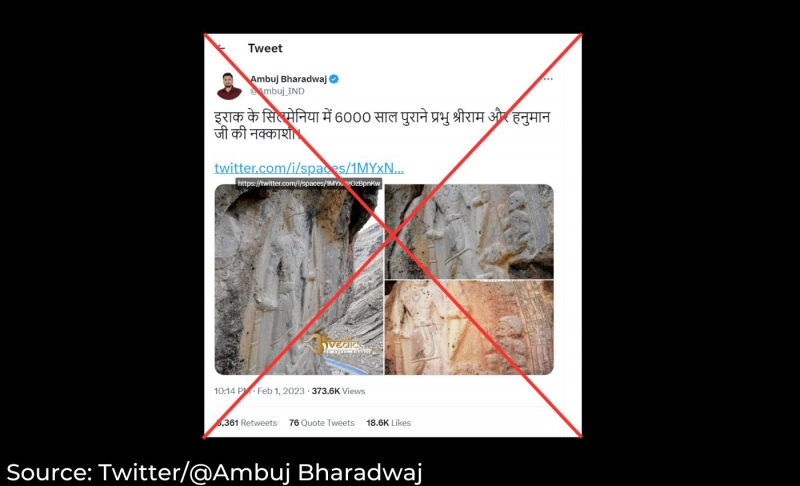By: Ankita Kulkarni
February 17 2023

A rock relief depicting Iraqi tribal king Tardunni has been falsely claimed to be sculptures of Hindu deities.
Context
An image of two rock reliefs in Iraq has gone viral on social media with the claim that they depict the Hindu gods Lord Rama and Hanuman. A verified account named Ambuj Bharadwaj shared the image on Twitter, along with the following claim, translated frrom Hindi: "6000 years old Lord Shriram and Hanuman ji's carvings in Silemania, Iraq." In the image, we can see rock reliefs of a man holding a bow, a quiver of arrows, a dagger in his belt, and two persons held captive at his feet. The post has 373.6K views and 22.6K likes. However, the rock sculptures are of local figures that are being misinterpreted as Hindu deities.
In Fact
Upon conducting a reverse image search, we found the image used in the Twitter post posted on Wikimedia Commons, titled, ‘Rock relief of ‘Darband-i Belula, Horen Shekhan, Sulaymaniyah, Iraq’. The image was posted on March 23, 2019, and credited to the author Osama Shukir Muhammed Amin FRCP (Glasg). The description of the photograph reads, "Darband-i Belula rock relief depicting a king, prince, ruler, or a high-ranking official, whose name reads Tar…dunni. He was probably a Lullubian, less likely a Gutian. The relief lies in Iraq, Sulaymaniyah Governorate, Horen Shekhan, near the Iraq-Iran border. Circa 2000 BC." One can also see the same carvings in a YouTube video uploaded by Osama on his channel.
We also found images of the rock relief shot from a different angle in a travel blog published on the free online history encyclopedia World History, authored by Osama. Describing the rock carving in his article, Osman notes that the person carved holding a bow and arrows looks like an early Sumerian ruler or warrior, and the two captives at his feet are probably Hurrians, a Bronze Age people who flourished across the Near East. He states that a rectangular box carved beside one of the captives on the right side shows Akkadian inscriptions that mention the warrior's name as "Tar...dunni," son of Ikki, who was a Lullubian king. The relief dates back to the Akkadian period, circa 22 century BCE. It also included a sketch of the relief scanned from the book of Taha Bakir and Fouad Safr in 1966.
Logically contacted an archeologist, Akshyeta Suryanarayan, PhD, a specialist in South Asian and Arabian archaeology, who confirmed that the relics in question do not depict Hindu deities. She added that the inscription on the side of the carving states his name, 'Tardunni,' and invokes the deities Shamash (ancient Mesopotamian sun god) and Adad (Ancient Mesopotamian storm and rain god) for protection. She also showed us the presence of the same image in the book The Archaeology of Iran from the Palaeolithic to the Achaemenid Empire (2022) by Roger Matthews and Hassan Fazeli Nashli. The image description notes that it depicts "rock reliefs of late third and early second millennia BC date in western Iran and eastern Iraq."
It is clear, therefore, that the reliefs do not depict Hindu deities and are instead depictions of a local king from the region.
The Verdict
A rock relief of Mesopotamian ruler, dating back to 2000 BC and carved into the Darband-i-Belula cliffs in Iraq, is being incorrectly claimed to depict the Hindu deities Lord Rama and Hanuman. Therefore, we have marked the claim as false.